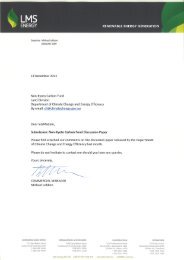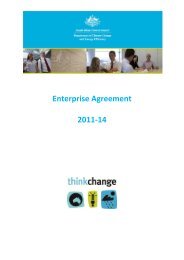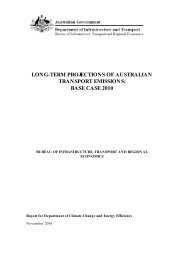Implications of Climate Change for Australia's World Heritage ...
Implications of Climate Change for Australia's World Heritage ...
Implications of Climate Change for Australia's World Heritage ...
Create successful ePaper yourself
Turn your PDF publications into a flip-book with our unique Google optimized e-Paper software.
5. ADAPTATION TO IMPACTS<br />
The IPCC defines vulnerability as ‘the degree to which a system is susceptible to, or unable to cope with, adverse effects <strong>of</strong><br />
climate change’ (IPCC 2001). It is a function <strong>of</strong> exposure, sensitivity and adaptive capacity, as illustrated in Figure 3.<br />
Figure 3. Components <strong>of</strong> vulnerability (Source: Allen Consulting Group 2005)<br />
Adaptive capacity includes both autonomous (or reactive) adaptation (adaptations that occur ‘naturally’, without interventions<br />
by public agencies) and planned adaptation by managers as the result <strong>of</strong> a deliberate policy decision (IPCC 2001).<br />
In the global context, climate change adaptation research is a relatively new and evolving field. As yet, little is known or<br />
understood about the adaptive capacity and sensitivity <strong>of</strong> many <strong>of</strong> the values <strong>of</strong> Australia’s <strong>World</strong> <strong>Heritage</strong> properties to<br />
the impacts <strong>of</strong> climate change, particularly with respect to some cultural values. However, based on our current level <strong>of</strong><br />
knowledge and understanding <strong>of</strong> climate change impacts, it is possible to classify the adaptive capacity <strong>of</strong> Australia’s<br />
<strong>World</strong> <strong>Heritage</strong> values (using UNESCO’s criteria as a proxy) into three broad categories 12 : low, moderate and high. This<br />
categorisation is based on a comparative analysis over all <strong>World</strong> <strong>Heritage</strong> values. These are summarised in Appendix B.<br />
The natural values listed in UNESCO’s criteria (ix) and (x) (i.e. ‘… examples representing on-going ecological and biological<br />
processes in [the] evolution’ and ‘… in-situ conservation <strong>of</strong> biological diversity, including those containing threatened species<br />
<strong>of</strong> outstanding universal value from the point <strong>of</strong> view <strong>of</strong> science or conservation’) have a low level <strong>of</strong> adaptive capacity to<br />
climate change. Because projected rates <strong>of</strong> climate change are likely to occur faster than the natural rate and frequency<br />
<strong>of</strong> climatic variation, many <strong>of</strong> the natural values such as our plants and animals will simply not have enough time to adapt.<br />
Hence human intervention is crucial to ensure that sustainable adaptive responses are developed and incorporated in<br />
management strategies. They there<strong>for</strong>e require, as a matter <strong>of</strong> priority, the application <strong>of</strong> appropriate adaptive management<br />
strategies to strengthen their resilience.<br />
A moderate level <strong>of</strong> adaptive capacity is assigned to those natural values listed under criteria (vii) and (viii) (i.e. geomorphic<br />
or physiographic features) and to the cultural values listed under criteria (iii), (iv), (v) and (vi) (i.e. outstanding example(s) <strong>of</strong> a<br />
traditional human settlement; or human interaction with the environment especially when it has become vulnerable under the<br />
impact <strong>of</strong> irreversible change).<br />
12 This comparative assessment is based on our current knowledge <strong>of</strong> climate change impacts on <strong>World</strong> <strong>Heritage</strong> values. It should also be noted that the<br />
amount <strong>of</strong> time and research devoted to the effects <strong>of</strong> climate change on <strong>World</strong> <strong>Heritage</strong> values is disproportionate between the natural and cultural<br />
values. A broad-scale state-<strong>of</strong>-the-art vulnerability assessment is required across all properties and values.<br />
33






